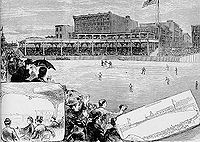This article has multiple issues. Please help improve it or discuss these issues on the talk page. (Learn how and when to remove these messages)
|
Union Base-Ball Grounds was a baseball park located in Chicago. The park was "very visibly downtown", its small block bounded on the west by Michigan Avenue, on the north by Randolph Street, and on the east by railroad tracks and the lake shore, which was then much closer than it is today. The site is now part of Millennium Park.
Baseball

Union Base-Ball Grounds was also called White-Stocking Park, as it was the home field of the Chicago White Stockings of the National Association in 1871, after spending the 1870 season as an independent professional club playing home games variously at Dexter Park race course and Ogden Park. The Great Chicago Fire of October 8 destroyed Union Base-Ball Grounds and all of the club's possessions. After fulfilling its 1871 obligations by playing on the road, the club did not field a team for the next two seasons, and the ballpark was not rebuilt.

In 1878, the White Stockings returned to the 1871 site and to a new park that is usually called Lake-Shore Park, Lake Front Park, or simply Lake Park, which was actually the name for the entire waterfront area (not just the ballpark) until being renamed Grant Park in 1901. At the new park, the outfield area was especially close in right field. The right field fence was less than 200 feet away, so anyone hitting the ball over that fence was awarded only a ground rule double. Batters would aim for the fence, and during their years at the park, the Chicago club regularly led the league in doubles. In what would be their final season on the lakefront, the White Stockings decided to make the entire outfield fence home run territory. Thus, the team slumped in the number of doubles while boosting their home runs from typically a dozen or two to 142, easily outdistancing second place Buffalo, which had 39 for the season. The entire league's home run totals were up, thanks to the change to the Chicago ground rules.
The team played at Lake-Shore Park through the 1884 season. After the season, the city reclaimed the land, and the White Stockings became a road team for the first couple of months of 1885 while awaiting construction of the first West Side Park. The lumber from the stands was disassembled and reconfigured as the new stands at West Side Park.
Football
The first college football game in the Midwest was played at the park on May 30, 1879, when the University of Michigan met Racine College. Michigan won, 1-0, on a place-kick by David DeTarr.
Notes
- Gilfoyle, Timothy J. (2006-08-06). "Millennium Park". The New York Times. Retrieved 2008-06-24.
- For the baseball season of 1872, the Chicago club leased another plot and built the 23rd Street Grounds that would be its home through 1877, renting it out chiefly to local clubs for two seasons before the White Stockings returned to the field in 1874. Several National Association games were played at 23rd St in 1872–1873: six in 1872, essentially because teams based in Cleveland and Troy were failing, and one in 1873 (Retrosheet). The Chicago club itself renewed play only in 1874
- In 1883, the second Lakefront Park opened. The second Lakefront Park is noted for its extremely short dimensions. A ball hit over the wall was normally considered a ground rule double. However in 1884, these short dimensions allowed the Cubs to set home run records that would not be broken until Babe Ruth over 30 years later. Ned Williamson, Fred Pfeffer, Abner Dalrymple, and Cap Anson each hit over 20 homers, with Williamson leading the way with 27. It is Lake Front Park, often with a numeral I or II, in recent reference works including Retrosheet and the 1986 edition of Lowry.
References
- Jack Bales, "Ballparks," WrigleyIvy.com.
- Jack Bales, Before They Were the Cubs: The Early Years of Chicago’s First Professional Baseball Team. Jefferson, NC: McFarland, 2019.
- Lowry, Philip J. (1992). Green Cathedrals. Addison-Wesley. ISBN 9780201567779.
- Retrosheet. "23rd Street Park in Chicago, IL". Retrieved 2006-08-31.
- Retrosheet. "Park Directory". Retrieved 2006-09-04.
External links
| Preceded byOgden Park & Dexter Park 23rd Street Grounds |
Home of the Chicago White Stockings 1871 1878 – 1884 |
Succeeded by23rd Street Grounds West Side Park |
41°53′2″N 87°37′26″W / 41.88389°N 87.62389°W / 41.88389; -87.62389
Categories: